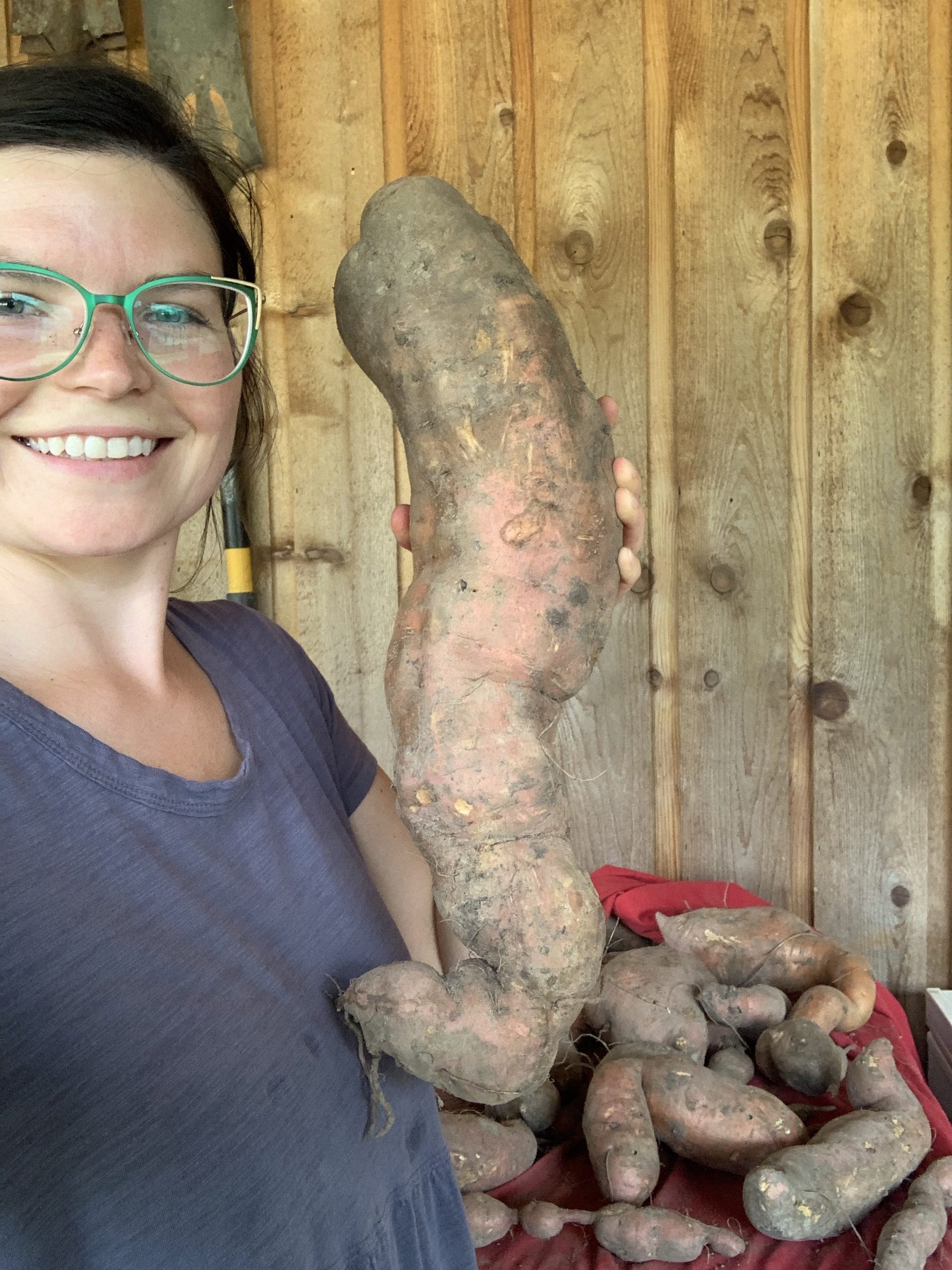Sweet potatoes. They are one of my favorite root vegetables. Due to their storage capabilities and nutritional content, they’re a great crop to grow to bulk up your food storage before winter.
This was our first year having a sweet potato harvest. Last year we grew ornamental sweet potato vines (admittedly, by accident…. story for another day), and the year before I tried growing sweet potatoes from, well, sweet potatoes. That doesn’t exactly work.
Sweet potatoes need to be grown from a slip. A slip is a growth, or little vine that sprouts off of the sweet potato. You can grow sweet potato slips by keeping one end of sweet potato suspended in water (use toothpicks balanced on the rim of the glass) and in a kitchen window in direct sunlight. Start this project in January or February depending on when you can plant them out. It’ll take a bit to get enough slips.
When your slips sprout, transfer them to a jar with a bit of water in the bottom so they will form roots. This is the slip you will plant in the ground.

We planted 45 slips around the middle of April. This took up about 75 row feet, divided into two 30 foot rows and one 15 foot row. We planted in an area that had previously been planted with brassicas and the soil was compacted at a depth of 4-5 inches. Each slip was planted 1 foot apart in the row and the rows are about 18 inches apart. Initially, we lost about 5-10 slips due to not being well acclimated to the sun. Our temperatures this season (summer 2022) got hot fast. They scorched some of the tender slips. Once the slips got established, they were very hands off. I just made sure they had adequate water, but they did tolerate drought like conditions.
Amendments
After our slips had grown several leaves and one or two more vines started to sprout off the initial slip, I mulched the area heavily with hay. Afterwards, I discovered the hay May have been contaminated with herbicide. I can’t be certain if it was, but my leaves did shrink up and curl. The tomatoes in a neighboring row died after mulching.
I watered the area heavily for several days. The vines continued to grow, but new leaves looked a bit shriveled. I left them be and never added any amendments to the area. It wasn’t long before the vines and leaves bounced back and started to spread everywhere. Nothing was safe near the vicinity of the vines!
Pruning
There were several times when we trimmed the vines just so we could walk by. Our cows loved them! They’re not toxic to cows as they are not in the nightshade family like a regular potato.
This was the extent of our pruning. Anytime the vines began to choke out a neighboring plant, I just cut them back. I did not keep clear walking paths in the area between each row of sweet potatoes. They were planted in a sort of rectangle, so I let them run as they pleased within that area.

Harvesting
Harvesting the sweet potatoes was a very spontaneous endeavor. After about 100 days, we checked the sweet potatoes to see how they were coming along. What we found was a massive sweet potato bulging out of the ground! Our potatoes were definitely ready for harvest.
We started by trying to fold the vines back on themselves. The video linked at the top of this article shows our method. After flipping the vines back on themselves, we cut the main vine at its base, leaving enough above ground to mark its place. Then we got to digging!
The layer of compaction was still present. A pitch fork did a good job at loosening the soil, but we were breaking too many potatoes in the process. Our hands were the best tool for the job. We set to scraping around the sweet potatoes instead of just pulling them up. Pulling caused them to break, but taking the time to dig them out kept us from breaking as many.
Once we were finished, the compacted soil was not so compacted. The potatoes and vines had done a wonderful job of loosening the soil. We found many sweet potatoes had spread into the pathways as well.

Total Harvest
From the 40 or so slips that lived, we had a great harvest! Our total weight of potatoes came out to 252.2 pounds! This did not include any of the stragglers we found in the following days as we mulched the area again.
I hope this information was helpful to you!